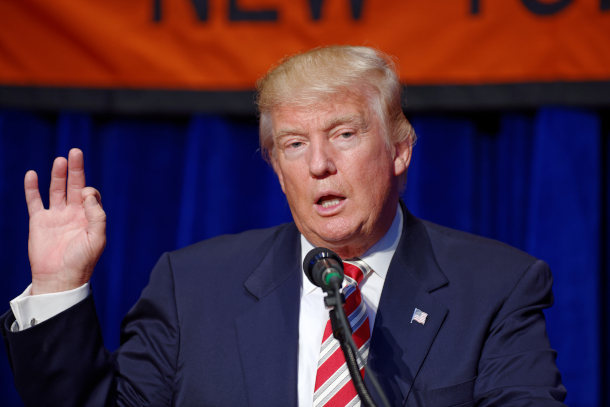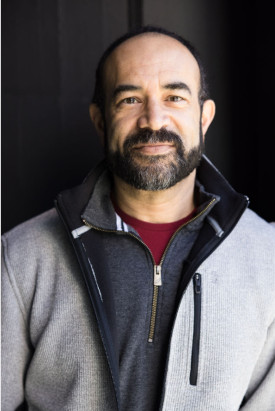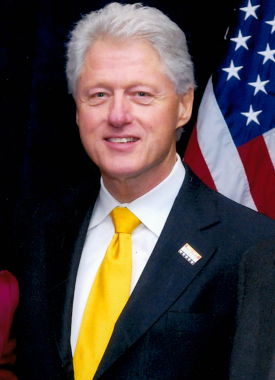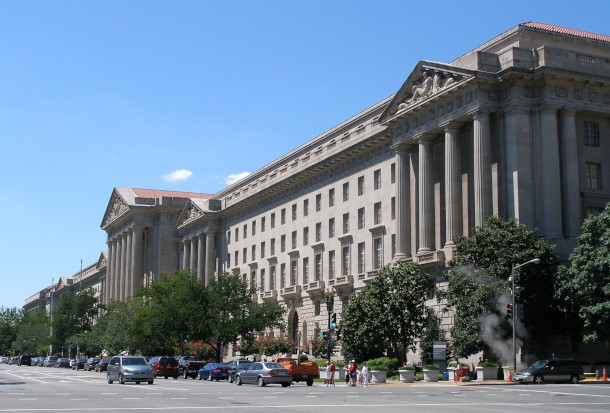Trump Dumps Environmental Justice
Air Date: Week of February 7, 2025

During his first week back in office President Trump signed several executive orders to roll back environmental justice policies. (Photo: Michael Vadon, Wikimedia Commons, CC BY-SA 4.0)
Black, Brown and low-income communities pushing back against industrial pollution have always had an uphill battle. But now those environmental justice fights may get even harder, as the Trump administration shutters federal environmental justice programs. Patrice Simms is Vice President of Litigation for Healthy Communities at Earthjustice and joins Host Jenni Doering to discuss the federal government’s role in protecting people from environmental discrimination.
Transcript
BELTRAN: It’s Living on Earth, I’m Paloma Beltran.
DOERING: And I’m Jenni Doering.
Exposure to pollution and the impacts of climate change hurts everyone, but Black, Brown and low-income Americans bear disproportionate burdens linked to discrimination. In the industrial part of Louisiana known as “cancer alley,” the majority Black residents face a cancer risk that is up to 47 times higher than the EPA’s acceptable limit, according to ProPublica. Environmental justice communities have been pushing back against pollution for decades, and sometimes justice does prevail. The environmental lawyers of Earthjustice recently helped Cancer Alley advocates fight the construction of a new Mitsubishi Chemical Group plant. It would have released hundreds of tons of dangerous air pollutants per year, including nitrogen oxides and formaldehyde. After the community opposition caused costly delays, Mitsubishi decided to cancel the project. But each fight for environmental justice takes a massive amount of effort on behalf of locals and advocates standing up to powerful industry. Well, now those fights may get even harder as the early moves of the Trump White House signal that this administration would rather not acknowledge the pollution burdens placed on EJ communities. Joining us now is Patrice Simms, a visiting professor at Harvard Law School and the Vice President of Litigation for Healthy Communities at Earthjustice. Welcome back to Living on Earth!
SIMMS: Thanks very much. It's a pleasure to be here.
DOERING: So, before we get into President Trump's recent actions regarding environmental justice, could you please talk us through the history of White House policy on EJ? What was the situation that President Trump inherited?
SIMMS: You know, the federal government really started paying attention to environmental justice, going all the way back to the early 90s. We saw a couple of things happen during the Clinton administration, starting in about 1992 with the creation of what later became the Office of Environmental Justice at EPA, and the signing of an executive order in 1994 by President Clinton. That was the first executive order directly addressing environmental justice, and we've seen a focus on environmental justice with varying degrees of seriousness and stringency over the years. One of the things that has been true through Democratic and Republican administrations since 1994 is that this Clinton-era environmental justice executive order has survived and has served a bit as an anchor to the federal government's approach to thinking about environmental justice.

Patrice Simms is Earthjustice’s Vice President of Litigation for Healthy Communities. He also serves as a visiting professor at Harvard Law School. (Photo: Smeeta Mahanti Photography)
DOERING: We just, of course, wrapped up with the Biden administration, which actually put environmental justice kind of at the center of what they were doing around environmental issues. What did that look like in terms of the White House approaching EJ?
SIMMS: Yeah, that's right. One of the things that we saw in the Biden administration, really starting as early as the campaign, was a recognition of the seriousness and importance of grappling with the challenges of creating environmental justice and grappling with environmental injustice. So, President Biden was really aware of the problem of environmental injustice and wanted to be deliberate about advancing environmental justice, speaking with environmental justice communities that were on the front lines of pollution across the country, and really thinking about what does it look like to do this well. And among the things that the Biden administration did was adopt some additional executive orders that gave instruction to the federal agencies to take further steps to make sure that they were paying attention to these problematic examples of discrimination in the context of pollution and exposures.
DOERING: So, President Trump has signed multiple executive orders regarding environmental justice. What are they and what impacts are they having?

Earthjustice is an environmental law nonprofit. Recently, they’ve fought against a new petrochemical plant in cancer alley. (Photo: Provided by Earthjustice)
SIMMS: In the first couple of weeks, President Trump withdrew or revoked all of the executive orders that President Biden had adopted that related to environmental justice in one way or another, but he also reached all the way back to the 1994 Clinton-era executive order and revoked that executive order as well. And as I mentioned, it's an executive order that survived for 30 years through Democratic and Republican administrations, and it survived that long because it really reflected this fundamental principle of fairness and non-discrimination, the idea that our federal government should be operating in ways that do not result in discrimination against groups based on race or income. So pretty significant the revocation of all of those executive orders. It's hard to imagine disagreeing with the premise that we should not be poisoning communities based on their race. You know, the withdrawal of that executive order problematically seems to suggest that this administration disagrees with that fundamental premise.
DOERING: What exactly are the tangible legal implications of what President Trump has done? — Since sometimes when he takes a step, it's a little bit more about the headlines than about the actual impact.
SIMMS: Yeah, well, there's obviously a lot of bluster and a lot of really, frankly, just sowing chaos that's happening right now. Some of it as a distraction, but some of it that will have some concrete and important impacts on real people. One of the signals that's being sent around environmental justice is, don't focus on, don't listen to, don't pay attention to communities on the front lines of pollution. Among the many things that environmental justice programs and strategies tried to do was make sure that voices and input from communities that are often on the very front lines of pollution and toxic exposure were sought out in the context of making important policy decisions or adopting and crafting regulatory programs that have to happen anyway, right, under statutes like the Clean Air Act that already require the regulation of air pollution. And that's among the things that environmental justice programming within federal agencies did. And if that stops, it means those voices, the participation of those communities and the decision-making processes could disappear.
It also could affect how enforcement happens. If you think about where EPA and other agencies that enforce the laws associated with pollution and exposure, how they're thinking about what they're trying to achieve with those enforcement strategies, that enforcement might say, hey, let's focus at least some of our energies on making sure that we're addressing those polluters that are violating the law in ways that are exposing these communities that are already overburdened and already on the front lines of pollution. And if the instruction to agencies is stopped doing that, then that pollution may continue, and those communities may continue to suffer. There's a host of reasons why this really matters, and it isn't a conversation really about policy and esoteric legal principles. We're really talking about pollution that causes cancer, that kills people, that sends children to the hospital with asthma attacks, that causes lost workdays, that causes lost school days. These are real consequences for real people, and often consequences for real people and real communities that are already also subject to all kinds of other burdens and marginalization.

Former President Bill Clinton signed the first executive order related to environmental justice back in the early 1990s. That order stayed in place until it was revoked by President Trump in January 2025. (Photo: LadyLorna860, Wikimedia Commons, CC BY-SA 3.0)
DOERING: We're talking about environmental justice issues that have to deal with communities of color being more affected by pollution than white communities. And I understand that there's actually a statute in the Civil Rights Act that addresses issues of the federal government perpetuating racism. So, what exactly is title six of the Civil Rights Act, and how does it relate to environmental justice issues?
SIMMS: Yeah, well, title six generally instructs the federal government to eliminate discrimination with respect to funds that it distributes, and largely that means the states. Title six was intended to prevent the federal government from outsourcing racial discrimination to the states through funding of racist practices at the state level. And it relates to environmental justice because among the things that states administer are environmental programs. And to the extent that they're administering environmental programs that receive funding from the federal government, which almost all of them do, they have an obligation to do that in ways that are non-discriminatory. That's what it means to comply with Title six of the Civil Rights Act. And EPA and other federal agencies have an obligation to make sure that those grant recipients are operating in ways that are non-discriminatory.
DOERING: So, Patrice, what options do you think environmental justice communities have for pushing back against threats to their health in these times, you know, during this second Trump administration?

Due to President Trump’s executive orders, many EPA employees fear for their jobs. Pictured above is EPA Headquarters in Washington D.C. (Photo: Coolcaesar, Wikimedia Commons, CC BY-SA 3.0)
SIMMS: Yeah, I think there's a couple of things. The withdrawal of executive orders and policies meant to ensure that federal agencies are really thinking about environmental justice, even with those having been withdrawn. The underlying statutes that direct what federal agencies have to be doing, statutes like the Clean Air Act, the Clean Water Act, the Safe Drinking Water Act, those statutes have substantive requirements about what has to be done, about what air pollutants have to be regulated, how they have to be regulated, and those statutes continue to provide vehicles for communities to fight for cleaner air, for cleaner water. Those substantive statutes like the Clean Air Act and Clean Water Act are very powerful, but they don't always ensure non-discrimination in environmental pollution and exposures. But even if the federal government decides to abandon principles of fairness and justice and non-discrimination, the states don't have to. And communities on the front lines of pollution and exposure will continue to engage in advocacy with their states to try to fill some of the gaps that the federal government is leaving, and we see already that some states are expressing an intent and willingness to step into the breach here and directly deal with environmental justice issues. That won't be true everywhere.
DOERING: These executive orders that the President has issued just in his first days seem to touch every aspect of the federal government. But specifically, how is this chaos, as you say, impacting agencies like EPA, and what could the long-term implications be for environmental justice if this continues?
SIMMS: Yeah, well, that's a really good question. And one of the most direct consequences for environmental justice that's an outgrowth of the executive order is sort of what it means for how federal agencies organize themselves, what staff they have, and what those staff are doing, what they're working on. One of the things that we've already begun to see in the wake of these executive orders is staff who have been previously working on environmental justice issues being put on leave with the expectation that many of those staff may ultimately be let go. So, what it means is that there's a direct consequence from these executive orders to the capacity of federal agencies like EPA to do their work, and especially to do the work that's focused on ensuring non-discrimination in environmental policy.
DOERING: You know, it seems like, from what I'm hearing from you, Patrice, it seems like a really stressful time to be in this position of advocating for environmental rights. What keeps you going?
SIMMS: Really significantly for me, what continues to motivate me is my tremendous respect and appreciation for the people on the front lines of pollution and exposures. I work really closely with communities across the country who are in very real ways, fighting for their lives, fighting for their families, fighting for their well-being, and fighting for their communities. And these aren't people who are getting paid to do this. These are people who are doing this because they have to. They're doing this because they're watching their children get sick. They're doing this because they're watching their communities die. And there's nothing more motivating than understanding and knowing the members of these communities, the work that they do, and the passion that they have for making sure that they're protecting their families and their communities. And it's an honor and a privilege to get to work with them and beside them and for them, and that keeps me going every day.
DOERING: Patrice Simms is the Vice President of Litigation for Healthy Communities at Earthjustice and a visiting professor at Harvard Law School. Thank you so much, Patrice.
SIMMS: Thank you. It's really been a pleasure to talk to you today.
Links
Discover where air pollution causes the most cancer in the United States
Living on Earth wants to hear from you!
Living on Earth
62 Calef Highway, Suite 212
Lee, NH 03861
Telephone: 617-287-4121
E-mail: comments@loe.org
Newsletter [Click here]
Donate to Living on Earth!
Living on Earth is an independent media program and relies entirely on contributions from listeners and institutions supporting public service. Please donate now to preserve an independent environmental voice.
NewsletterLiving on Earth offers a weekly delivery of the show's rundown to your mailbox. Sign up for our newsletter today!
 Sailors For The Sea: Be the change you want to sea.
Sailors For The Sea: Be the change you want to sea.
 The Grantham Foundation for the Protection of the Environment: Committed to protecting and improving the health of the global environment.
The Grantham Foundation for the Protection of the Environment: Committed to protecting and improving the health of the global environment.
 Contribute to Living on Earth and receive, as our gift to you, an archival print of one of Mark Seth Lender's extraordinary wildlife photographs. Follow the link to see Mark's current collection of photographs.
Contribute to Living on Earth and receive, as our gift to you, an archival print of one of Mark Seth Lender's extraordinary wildlife photographs. Follow the link to see Mark's current collection of photographs.
 Buy a signed copy of Mark Seth Lender's book Smeagull the Seagull & support Living on Earth
Buy a signed copy of Mark Seth Lender's book Smeagull the Seagull & support Living on Earth

